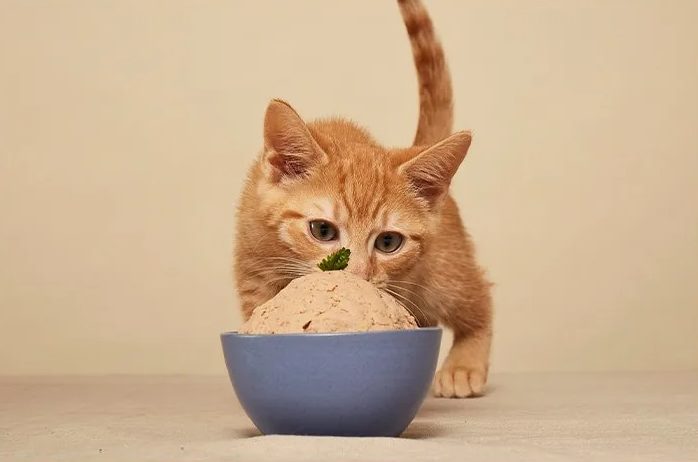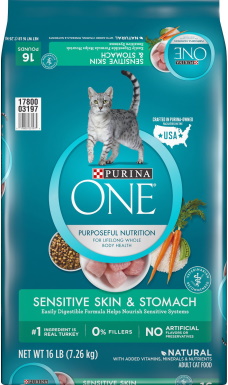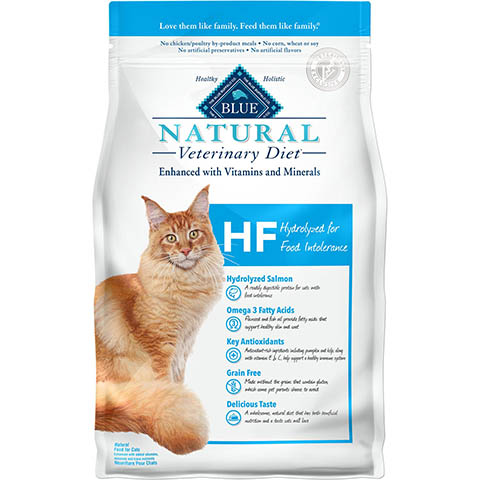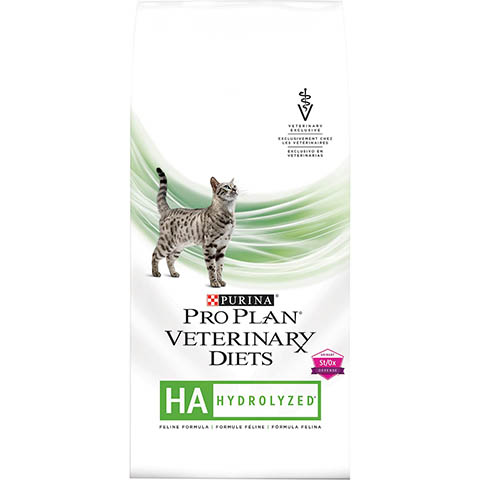Cats can suffer from allergies just as we do! Mild allergies and general intolerances are surprisingly common. Intolerances may go unnoticed with poor coat condition, itchy skin, and stomach upset, all often misdiagnosed as other health problems. Thankfully, severe allergies that will cause your cat to be very sick are rare.
Suppose you suspect your cat isn’t in tip-top condition. In that case, you should first contact your vet for advice to rule out any more severe causes of poor health before exploring the possibility of a food allergy or intolerance. Going down this path can take time and patience to identify the cause and find the right food for your sensitive feline.
To help out, we have compiled a list of the top 13 best cat foods for allergies! Each product is backed by positive reviews of cat owners who have successfully eased their own cats’ reactions to common allergens in their diet.
Disclaimer: The foods reviewed here were chosen because they have certain characteristics that might help with some of the causes or consequences of this medical condition. However, they are not a medical treatment or a substitute for medical treatment. Keep in mind that each medical case is different and what works for some pets may not work for others. Your veterinarian is the right person to advise you on the best diet for your pet’s case.
A Quick Glance at Our Favorites (2024)
| Image | Product | Details | ||
|---|---|---|---|---|
| Best Overall |

|
Smalls Fresh Human-Grade Cat Food |
|
Click to Save 40% Use code: Petkeen2023 |
| Budget Buy |

|
Purina ONE Sensitive Skin & Stomach Dry Cat Food |
|
Check Price |

|
Royal Canin Vet Protein PR Dry Cat Food |
|
Check Price | |

|
Blue Buffalo Basics LID Kitten Turkey |
|
Check Price | |

|
Blue Buffalo Natural Vet HF Hydrolyzed Cat Food |
|
Check Price |
The 13 Best Cat Foods for Allergies
1. Smalls Fresh Cat Food ‘Other Bird’ Recipe – Best Overall
| Calories: | 1,415 kcal/kg |
| Fat: | 7.5% |
| Protein: | 17% |
| Main Ingredients: | Turkey thigh, chicken liver, green beans |
Some cats are prone to allergies triggered by certain ingredients in their food. Small cat food eliminates such triggers with their fresh, human-grade ingredients that cats love. All meals are rich in protein, and you can even choose different textures for your picky feline pal, such as pâté, shredded, and ground. All meals are gently cooked and contain no preservatives or mystery meat. The company also adheres to AAFCO’s nutritional standards, so you can trust your cat is getting the best ingredients possible.
You have three different options for a protein source: bird, cow, or other bird, which is diced turkey thigh with chicken liver mixed in the recipe. Their fresh bird recipe includes chicken liver, chicken thighs, chicken breasts, and chicken heart. The fresh cow recipe contains 90% lean ground beef, beef liver, and beef heart.
In addition to cat food, Smalls offers treats, broth, and supplements. You do need a subscription to receive this food, and it can be pricey, but they do offer samples once you decide on a plan that fits your budget with an additional 40% off your regular subscription plan.
2. Purina ONE Sensitive Skin & Stomach Cat Food – Budget Buy
| Calories: | 430 kcal/cup |
| Fat: | 13% |
| Protein: | 34% |
| Main Ingredients: | Turkey, chicken by-products, meal (corn, soy, oats) |
This product is specifically designed for cats with sensitive skin and stomachs. We have chosen it as our best cat food for allergies for the money due to its great value. Not only is it affordable, but it has also proven to be a great choice for a balanced and supporting diet for sensitive cats.
All ingredients in this food are added for a purpose. This includes extra antioxidants and vitamins designed to strengthen the immune system to create resilience against mild allergies. Due to having no extra fillers, additives, colors, or artificial preservatives, this food is great for those cats whose allergies come from these additional unnatural ingredients.
This food features turkey as the primary protein ingredient but also contains chicken by-products for extra protein. This means this food is not suitable for cats with chicken allergies.
It also contains other common allergens, such as soy, corn, and grains. While this product is highly reviewed to help cats with mild allergies, it will likely not be suitable for more severe allergies and reactions to these common ingredients.
3. Royal Canin Vet Protein PR Dry Cat Food
| Calories: | 334 kcal/cup |
| Fat: | 11% |
| Protein: | 30% |
| Main Ingredients: | Rabbit, pea products, hydrolyzed soy |
Royal Canin Selected Protein is considered one of our top picks for the best cat food for cats with skin allergies, as it is highly reviewed to be very effective. It does require a vet prescription and is on the more expensive side, but it is supported by many happy cat owners who found their “holy grail” product in this food.
Added vitamins and minerals support cats’ skin by creating a barrier to reduce irritation from allergic reactions. As a bonus, despite being marketed as an adult cat food, its ingredients are also adequate to support a developing kitten.
The ingredients are limited, with only one novel protein source (rabbit) and no chicken products meaning the risk of protein-related allergies occurring is very low. It does contain soy which may be a worry to some, but the soy ingredients are hydrolyzed to increase digestibility and reduce the risk of becoming an allergen.
4. Blue Buffalo Basics Limited Grain-Free – Best for Kittens
| Calories: | 109 kcal/cup |
| Fat: | 7% |
| Protein: | 9% |
| Main Ingredients: | Turkey (meat, broth, and liver), fish oil, pea flour |
While a wide range of diets is created to cater to adult cats with allergens, it seems to be harder to find hypoallergenic products that will support the growth and development of healthy kittens.
This product is a true “limited ingredient diet” and lacks most cats’ most common allergens. In place of these filler allergens, this food is packed full of real fruits and vegetables such as cranberries, blueberries, and pumpkin. These natural sources of vitamins and minerals will support sensitive kittens to promote excellent general health.
While this kitten food is widely highly reviewed, poor reviews include that some pickier cats would not eat it. In addition, owners report that it has made their kitten’s poops very pungent! It’s best to order this product in sample size before a full purchase to avoid wasting it with a picky kitten.
5. Blue Buffalo Natural Vet HF Hydrolyzed Cat Food
| Calories: | 430/cup |
| Fat: | 14% |
| Protein: | 30% |
| Main Ingredients: | Hydrolyzed salmon, and pea products |
This vet-prescribed diet is another excellent cat food for allergies. It contains just a single animal protein source, making it a limited-ingredient diet to reduce the risk of exposing your cat to allergens. The protein source, salmon, is hydrolyzed to make it more digestible and less likely to cause an adverse allergic reaction.
This product is also free from grains, wheat, corn, dairy, and soy, all very common allergens for cats. By avoiding many of the top allergens amongst cats, this cat food has gathered many glowing reviews for being an excellent choice for many sensitive cats.
The downside is it does require a vet prescription to purchase. When discussing a diet for your sensitive cat with your vet, keep this product in mind and discuss how it may suit your cat’s needs. In addition to needing a prescription, this product is also on the higher end of the cost scale compared to other similar products.
6. American Journey Duck Recipe Grain-Free Dry Cat Food
| Calories: | 410/cup |
| Fat: | 15% |
| Protein: | 40% |
| Main Ingredients: | Duck, chicken meal, pea products |
Duck is used as the primary source of protein in this cat food. It is highly reviewed to be one of the best hypoallergenic cat foods, with negative reviews mostly revolving around their cat’s personal preference for taste.
While the main ingredient is a novel protein, the next ingredient is chicken meal, so this product is not suitable for cats with allergies to chicken. It is, however, grain-free, so it is great for cats with grain-related allergies. It also lacks artificial colors or preservatives, which are often the culprit in food-related allergies.
This product includes a wide range of real fruits and vegetables to provide essential vitamins and minerals for good health instead of grain fillers. This includes apples, carrots, blueberries, cranberries, spinach, and pumpkin. Sounds better than some of our diets!
7. Purina Pro Plan Vet HA Hydrolyzed Formula Dry Cat Food
| Calories: | 350/cup |
| Fat: | 9% |
| Protein: | 30% |
| Main Ingredients: | Hydrolyzed soy protein, hydrolyzed chicken liver, rice starch |
This is another product that requires a vet prescription, but it is a great choice for many cats. It is specifically designed to assist digestion and gut harmony in cats with sensitivities. It is also suitable for other gut-related diseases, including an inflamed bowel and pancreatitis.
With a single protein source that has been hydrolyzed for efficient digestion, the digestive system’s risk of an allergic reaction is very low. It is veterinary-approved and recommended, and many reviewers say it is one of the best cat foods for allergies.
In addition to the easily digestible protein source, the primary carbohydrate source is also designed to be easy on sensitive stomachs. Rice starch is low allergen compared to other common carbohydrate sources in cat foods. It is also pea-free, which is rare for many cat foods, even hypoallergenic recipes. This makes this a great choice for cats who suffer pea sensitivities.
8. Go! SENSITIVITIES Limited Ingredient Duck Dry Cat Food
| Calories: | 464/cup |
| Fat: | 15% |
| Protein: | 31% |
| Main Ingredients: | Duck, egg, lentils, chickpeas |
The main ingredient of this cat food is the novel protein, duck. This protein is unlikely to cause allergic reactions, and in this food, it is the only animal protein source. This limited ingredient recipe is also grain-free and instead contains lentils and chickpeas for vitamin boosts.
Some negative reviews of this product are that it contains chicken fat, which seems like it goes against the single protein marketing. While at first, this may seem like some time to avoid if your cat has chicken sensitivities, chicken fat is not actually a protein allergen.
Chicken fat does not contain the chicken proteins that are common allergens, so it will not elicit an allergic reaction. Instead, it is an excellent source of vital fats your cat needs.
9. Natural Balance L.I.D. Green Pea & Duck Dry Cat Food
| Calories: | 410/cup |
| Fat: | 12% |
| Protein: | 30% |
| Main Ingredients: | Duck, peas |
This limited ingredient cat food contains precisely what is marketed. The name of the flavor is green pea and duck, which are the two main ingredients in this food. This product is a great hypoallergenic choice without common allergens such as grains, soy, corn, or chicken.
This product also contains limited carbohydrate sources. While small amounts of carbohydrates make up part of a healthy cat diet, many different carbohydrate sources can create a problematic product for sensitive cats to digest.
On the flip side, this product has had some negative reviews since changing its formula to include salmon oil. Often duck flavored cat foods are chosen for cats with seafood intolerances, so, with this addition, this product is no longer suitable for cats with fish allergies.
10. Blue Buffalo Sensitive Stomach Chicken Adult Dry Cat Food
| Calories: | 422/cup |
| Fat: | 16% |
| Protein: | 32% |
| Main Ingredients: | Chicken, rice, oatmeal |
While this product contains both chicken and egg proteins, making it unsuitable for these particular allergies, it is highly reviewed to be helpful for many general intolerances and sensitivities. It is free from corn, wheat, soy, and artificial additives which are all common causes of food allergies in cats.
It also includes the addition of natural prebiotics to assist in healthy digestion. This can help to reduce the effects of mild intolerances by increasing absorption efficiency. Plentiful omega-3 and omega-6 fatty acids also promote great skin and coat health to counteract any effects of mild allergies.
11. Instinct Limited Ingredient Grain-Free Real Salmon
| Calories: | 517/cup |
| Fat: | 17% |
| Protein: | 5% |
| Main Ingredients: | Salmon, peas |
This food is a limited-ingredient product and contains just one protein and one vegetable source. This limits the risk of allergic reactions in sensitive cats. Of course, with salmon as the main ingredient, it is not suitable for cats with fish intolerances.
This product is highly concentrated in protein and fat without extra grain, soy, or wheat fillers. The high protein is beneficial for cats, but the high-fat content means a regular serving of this product is higher in calories than many other typical cat foods. If managing your cat’s weight is an ongoing issue, you will have to closely manage feeding and activity with this product.
12. Blue Buffalo Freedom Fish Grain-Free Canned Cat Food
| Calories: | 156/5.5 oz can |
| Fat: | 5% |
| Protein: | 5% |
| Main Ingredients: | Fish, chicken, carrots |
As you’ll see, many of the top-rated and reviewed hypoallergenic cat foods tend to be dry food. But there are also many offerings of wet food for cats with allergies. This product is grain-free and free from other common allergens such as wheat, corn, dairy, and soy. While its main protein source is cod and whitefish, it also contains chickens, so it is unsuitable for chicken protein allergies.
In addition to the soft consistency being more suited for older cats who struggle to eat hard food, it also is designed to support the passing of hairballs and general urinary health. These multi-benefits will suit aging cats who are more vulnerable to these issues.
13. Instinct Limited Ingredient Pate Rabbit Canned Cat Food
| Calories: | 156/5.5 oz can |
| Fat: | 3% |
| Protein: | 10% |
| Main Ingredients: | Rabbit, pea products |
If your cat is sensitive to animal proteins such as chicken, beef, seafood. Or, if they are intolerant to grains, wheat, soy, corn, dairy, or eggs, then this product may work for you! This limited ingredient of wet food truly is very limited in common allergens. It has rabbit as the novel protein to avoid protein allergies while offering high-protein and low-fat benefits.
It does contain peas and other pea products. Pea can be a great ingredient for protein, binding, and extra vitamins, but it is an allergen. While less common than other allergies, it may be a cause of sensitivity in your cat.
Buyer’s Guide: Selecting the Best Cat Foods for Allergies
What Causes Allergies in Cats?
There are three leading causes of allergies in cats: fleas, environment, and food. Allergies arise when your cat’s immune system overreacts to a substance they encounter, either by ingestion or airborne contact.
Cat food allergies are pretty uncommon, with only 0.1% of cats being affected. But those that are affected by food allergies are more prone to getting skin infections than those without allergies.
The most common cat allergies tend to be common cat food ingredients such as animal proteins like chicken, beef, and seafood. Intolerances are slightly different from true allergies in that they stem from digestion problems rather than an immune response. Intolerances often rise from common cat food ingredients such filler-type ingredients including grains, egg, dairy, wheat, corn, and soy. Many cats are also intolerant to artificial ingredients such as flavors, colors, and preservatives.
While fundamentally different, allergies and intolerances are often used interchangeably. They tend to show the same symptoms, undergo the same diagnostic process, and use the same diet treatment plan.
So, how do cats come to have food allergies? Well, no animal is born with allergies, not humans and not cats. Allergies develop over time as an immune response. So, your cat will only develop an intolerance to food it has been exposed to overtime. This is not to say that if you feed your cat the same type of food, it is sure to develop an allergy. The development of allergies is out of your control as a pet owner. It tends to be quite random but can be influenced by hereditary traits. They can show up at any age and tend to get worse over time.
Identifying the Cat Allergen
As you probably can tell, there is a wide range of culprits for food allergies and intolerances in cats. If your cat is showing symptoms of a reaction to food, the trick is trying to figure out precisely the ingredient causing the issue. Considering most regular cat foods are made up of a whole heap of common allergens, pinpointing the problem ingredient can be challenging.
Tests exist to test allergies from skin scrapings and saliva samples, but these tests are often unreliable, with some tests confirming allergies in pieces of fake fur! More often than not, your vet is going to recommend an elimination diet.
An elimination diet will usually start with moving your cat to an entirely novel and limited-ingredient diet. Novel means a protein they have never ingested before, so there is no chance of an allergic reaction.
Once they are settled into this new diet, you can very slowly introduce new ingredients one at a time until the culprit causing an adverse reaction is pinpointed. It’s important to only introduce a new ingredient after a few days, as an allergic reaction can occur anywhere from immediately after ingestion to up to a few days later.
If investigating mild food intolerances at home, you can keep trying new diets until you find one that doesn’t cause a reaction. Often you will see grain-free products being marketed intensively for cats with allergies. While grains can undoubtedly be allergens, they are not the most common cause of food allergies; animal proteins are. The best place to start is removing animal proteins and introducing novel proteins, as the most common causes of cat food allergies are chicken, beef, and fish.
Be aware that there is no true completely hypoallergenic product, as different cats will have different allergies, so no one product can exclude all possible allergens. Finding the right diet for your cat and identifying the problem allergen takes time and patience!
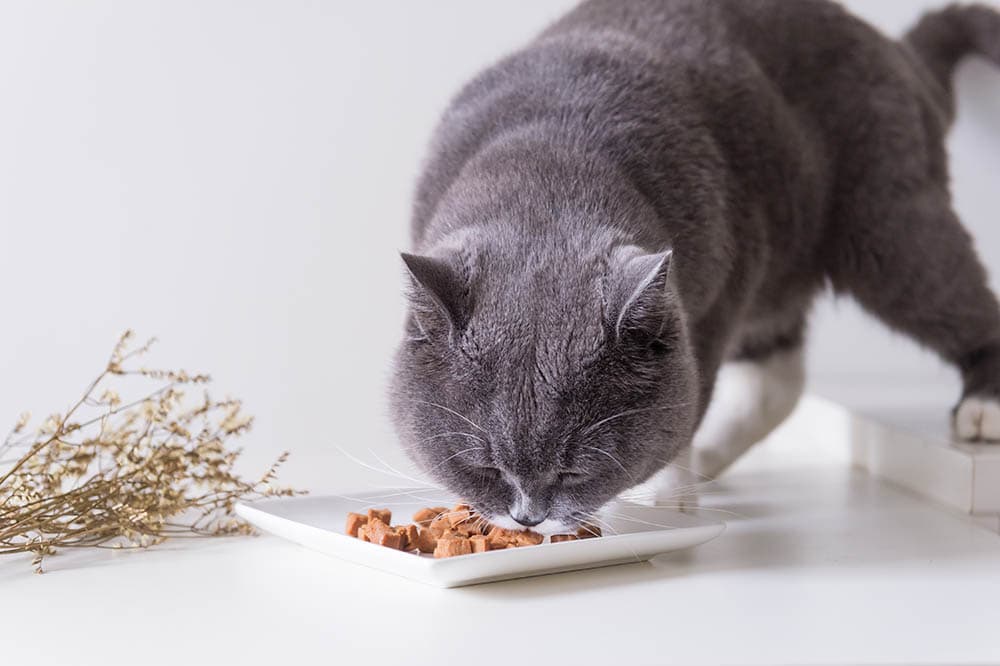
What to Look for in Hypoallergenic Cat Food
- NO MESS - The 360° tray on this cat food and water bowl set has a raised design to catch and...
- WHISKER FRIENDLY - Shallow and wide metal containers with flat bottoms ensure your kitty can enjoy...
- CHEW-SAFE MATERIALS - Kittens and cats love chewing on silicone and soft rubber - but it's a choking...
High-quality cat food is an important part of fostering a long and healthy life for your cat but the right cat food and water dish will promote good posture, offer whisker relief, and aid in good digestion. The Hepper NomNom Cat Bowl is our favorite bowl since it offers all of the above and is beautifully crafted to meet modern home stylings. The wide tray design catches any food and water spills and the entire setup is dishwasher safe. Learn more about the Hepper NomNom Cat Bowl here.
At Pet Keen, we’ve admired Hepper for many years and decided to take a controlling ownership interest so that we could benefit from the outstanding designs of this cool cat company!
Conclusion
Finding the right product can be a process when it comes to a diet for your cat with allergies. Our top pick is Smalls Fresh Cat Food for its use of limited-quality ingredients and the absence of allergens. We recommend Purina ONE Sensitive Skin & Stomach Dry Cat Food for the best value. It is affordable and recommended by many vets. This product has many brilliant reviews and is an excellent place to start.
Our best tip for your journey ahead is to only buy small quantities of any new foods until you find the product for you, that way, you don’t have food and money going to waste if it isn’t suited for your cat. Good luck on your journey to finding the best diet for your sensitive cat!
- You may also be interested in: 9 Best Cat Foods for Hairballs – Reviews & Top Picks
Featured Image Credit: Sergey Fatin, Shutterstock





